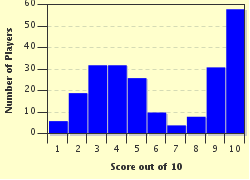Quiz Answer Key and Fun Facts
1. What is strange about Earth's moon compared to other planets and their moons?
2. Much like a spinning top, Earth's axis is rotating, or "wobbling" along with Earth itself. How long does it take for a full rotation of Earth's axis?
3. What is an earthrise?
4. For a time, Earth was thought to be the center of the Solar System. What is this model called?
5. Many space probes (spacecraft aimed beyond Earth orbit) have been launched from Earth over the history of space flight. What was the first probe to be launched?
6. What is a sidereal year?
7. If viewing Earth from another object in space, what would the longest day of the year be?
8. There is a small asteroid called Cruithne that is sometimes referred to as Earth's second moon. Why is this?
9. What shape is Earth defined as scientifically?
10. Why is Earth not named after a god like other planets?
Source: Author
jonthomas
This quiz was reviewed by FunTrivia editor
WesleyCrusher before going online.
Any errors found in FunTrivia content are routinely corrected through our feedback system.


